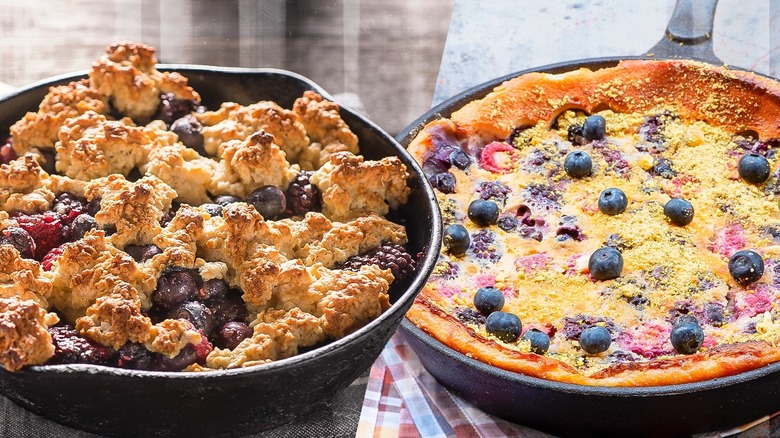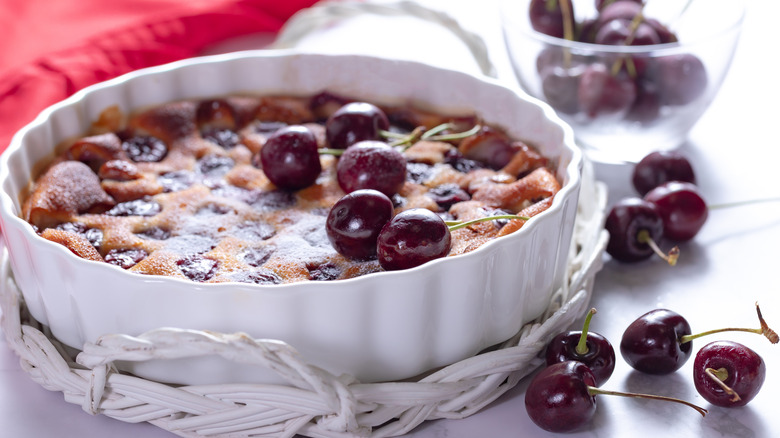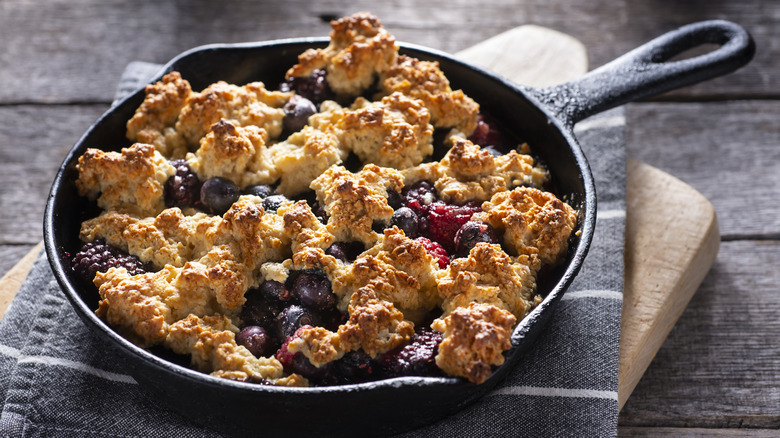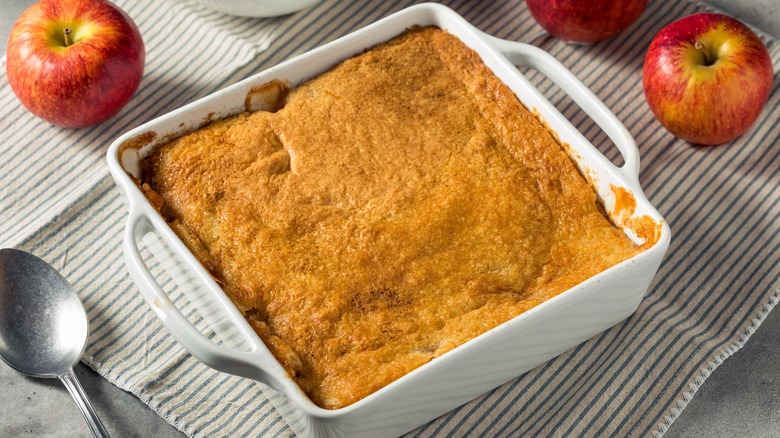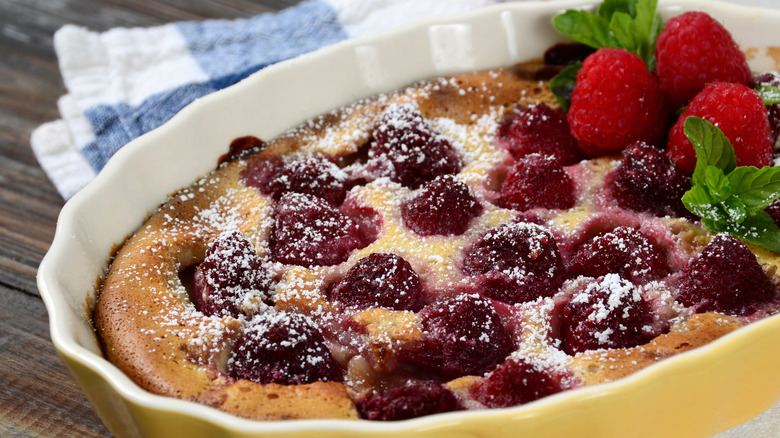Clafoutis Vs Cobbler: What's The Difference?
When presented with a large batch of fresh fruit, there are many options for enjoyment: compotes, ice creams, or simply a delicious fruit bowl. Yet there's something extra magical about a bake; melded into a dough, the additions take on a reinvented character.
There's an extensive selection of fruit-forward desserts, but for two especially tasty — and simple — options, consider clafoutis and cobbler. The former crafts berries and fruit into a fluffy, pancake-like batter, utilizing the filling's natural palate to flavor the dessert. Conversely, a cobbler offers a more pie-like experience, with a sugared medley of fruits topped with a crisped biscuit.
Both reach for delectable fruits, employing both their taste and texture for a tasty result. Yet they couldn't be more different in their methodology, showcasing varying techniques of baking. So, let's dive into all the distinctions between these two creations — they are undoubtedly both worth a spot on the dining room table.
What is clafoutis?
Clafoutis is an egg-heavy baked dessert, with a batter reminiscent of breakfast foods like pancakes and waffles. The tasty creation hails from Southern France, where it has been consumed for several centuries. Traditionally, it's crafted with black cherries, left pit-in for a distinct flavor, and offering the dessert a bold pop of purple color. However, nowadays, clafoutis is flavored with an array of seasonal fruits, ranging from berries to apples, plums, and more.
The freshness of the main element is critical; the quality of the fruit defines the dish's flavor. However, some also add dried fruit like raisins for a textural change-up. Additional flavors come in the form of vanilla extract, and some integrate almond extract for a hint of nuttiness.
The dessert's batter comes together readily, mixing together eggs, flour, milk, sugar, and a touch of salt. Clafoutis is then cooked in a heftier baking pan or even in a cast-iron skillet. The aim is for a lightly browned custard that can be sliced into wedges and enjoyed.
What is a cobbler?
Cobblers refer to a malleable range of dishes, defined by a syrupy fruit bottom traditionally topped with biscuit pastry. It's often confused with crisps and crumbles, although it's the top layer of dough that separates the dish from the rest. Today, however, many renditions have evolved to utilize either shortcakes or other cake batters.
Regardless of the dough, the dessert is spooned into a serving vessel for a moist but not runny consistency. Such a texture is achieved through the utilized fruit; cobblers reach for less watery varieties so as to not turn the dough too mushy during cooking. Popular fillings include cherries, peaches, apples, plums, and varying berries, although cobblers are open to varying fillings.
The dessert has been around in the U.S. for centuries, tracing to pre-revolutionary times. It's a modified rendition of British suet puddings, which could also contain savory flavorings, hence the dish's variability. Since their origin, cobblers have taken on many regional variations, which have spun off into distinct desserts like Betty's, crumbles, and more.
Clafoutis offers a different texture than cobbler
Clafoutis's wobbly batter translates to a delicious consistency: moist, homogenous, and tender, with a richness reminiscent of pudding but an airier texture. Nailing such a custard can be tricky — when overcooked, it turns chewy in an unpalatable way, so it's paramount to cook for precisely half an hour. Such a distinct balance creates a uniquely textured dessert, somewhere between cake and crème brûlée. And while the fruit filling is generous, it's not the majority of the texture, like in a cobbler.
Alternatively, cobblers serve up a fruit-forward medley with a slightly congealed but nonetheless runny filling. The dough isn't the centerpiece of the dish; although its top should have a pleasing crisp texture to contrast the fruit filling. Meanwhile, the side touching the fruit gets delectably infused with syrup, acquiring a tender texture. To thicken the filling and cook through the dough, cobblers necessitate a longer amount of cooking time than clafoutis, closer to an hour duration. Once done, the dish takes on a beautiful assortment of textures, melding into a delicious bite.
Clafoutis showcases a fresher fruit flavor than a cobbler
Clafoutis and cobbler utilize fruit in differing ways. In the former, the custard is a vessel for seasonal exemplars, with the ingredient's flavor gently infusing the custard. In classic renditions, like with cherries, each berry is a bright, tangy bite meant to juxtapose the custardy filling. As a result, a few additional flavors are incorporated — perhaps just a touch of lemon zest for tang or a spoon of vanilla extract.
Cobblers are much more open-ended with fruit additions: fresh, frozen, and canned ingredients are all utilized. To attain the desired syrupy texture, sugar is added to the filling, and blending together fruits is common. A touch of tartness can be introduced through creative additions like rhubarb or pomegranate, or the dessert can take on a winter character with the addition of spices. Contrary to clafoutis, the fruit needs to be cooked down, which lends the dish more malleability in the integrated flavors. As a result, cobblers are more compote-like in palate, as opposed to clafoutis's more natural fruit taste.
